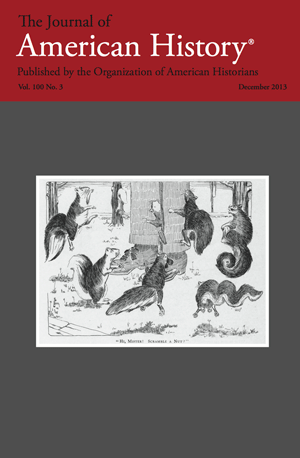
The Urbanization of the Eastern Gray Squirrel in the United States
Etienne Benson
Primary Sources
Exercise 1: Pets or Pests?
- The section on “Habits” in the entry on Sciurus migratoris (Migratory Gray Squirrel/Northern Gray Squirrel) in John James Audubon and John Bachman, The Viviparous Quadrupeds of North America (New York,, 1846), 265–73, available at the Internet Archive: https://archive.org/details/viviparousquadru45audu
Local copy of article (PDF)
- Illustration of Sciurus migratorius, Plate XXXV from Viviparous Quadrupeds: http://digitalgallery.nypl.org/nypldigital/dgkeysearchdetail.cfm?trg=1&strucID=212764&imageID=400038&word=Audubon%2C%20John%20Woodhouse&s=3¬word=&d=&c=&f=4&k=4&lWord=&lField=&sScope=&sLevel=&sLabel=&total=153&num=20&imgs=20&pNum=&pos=36
Local copy of img (JPG)
Exercise 2: Bringing the Wild into the City
- Map of Central Park from the Thirteenth Annual Report of the Board of Commissioners of the Central Park (1870), available at Wikimedia Commons: http://commons.wikimedia.org/wiki/File:1870_Vaux_and_Olmstead_Map_of_Central_Park,_New_York_City_-_Geographicus_-_CentralPark-knapp-1870.jpg
Local copy of img (JPG)
Exercise 3: Community and Charity
- Marian Longfellow, “The Pensioner in Gray,” St. Nicholas, 36 (Nov. 1908), 11, available via Google Books: http://books.google.com/books?id=FhUbAAAAYAAJ&lpg=PA11&ots=th4G0gTFzE&dq=%E2%80%A2%09Marian%20Longfellow%2C%20%E2%80%9CThe%20Pensioner%20in%20Gray%2C%E2%80%9D&pg=PA11#v=onepage&q=%E2%80%A2%09Marian%20Longfellow,%20%E2%80%9CThe%20Pensioner%20in%20Gray,%E2%80%9D&f=false
Local copy of article (JPG)
Exercise 4: Reforming Wayward Youth
- Ernest Thompson Seton, “Around the Campfire,” Boys’ Life, 4 (April 1914), 23, available at Google Books: http://books.google.com/books?id=hfVhPFxv5I8C&lpg=PA1&dq=Ernest%20Thompson%20Seton%20%E2%80%9CAround%20the%20Campfire%E2%80%9D%20%201914%20squirrels&pg=PA23#v=onepage&q&f=false
Local copy of article (JPG)
Exercise 5: “Scramble a Nut?”
- Laurence Freeman Peck, “Hi Mister! Scramble a Nut?,” Harvard Lampoon, Dec. 17, 1903, p. 121, available at Harvard Magazine: http://harvardmagazine.com/2014/01/squirrely
Local copy of image (JPG)
Exercise 6: Immigrants, Poachers, and the Limits of Community
- “Struck Down by Poachers,” New York Times, Dec. 17, 1900, p. 10, available at the New York Times Article Archive: http://select.nytimes.com/gst/abstract.html?res=F30C1EF63F5911738DDDAE0994DA415B808CF1D3
Local copy of article (JPG)
- “This Italian Must Beware,” Cambridge Tribune, Oct. 10, 1903, p. 6, available at the Cambridge Public Library: http://cambridge.dlconsulting.com/cgi-bin/cambridge?a=d&d=Tribune19031010-01.2.53
Local copy of article (JPG)
Exercise 7: From Charity to Ecology and Animal Rights
- J. Hadidian et al., “Urban Gray Squirrel Damage and Population Management: A Case History,” Third Eastern Wildlife Damage Control Conference (Lincoln, 1987), 219–27, available at DigitalCommons@University of Nebraska-Lincoln: http://digitalcommons.unl.edu/ewdcc3/19/
Local copy of article (PDF)
Additional Sources
Exercise 1: Pets or Pests?
- Richard W. Thorington Jr. and Katie Ferrell, Squirrels: The Animal Answer Guide (Baltimore, 2006)
- Richard Rhodes, John James Audubon: The Making of an American (New York, 2004)
- Katherine C. Grier, Pets in America: A History (Chapel Hill, 2006)
Exercise 2: Bringing the Wild into the City
- Colin Fisher, “Nature in the City: Urban Environmental History and Central Park,” OAH Magazine of History, 25 (Oct. 2011), 27–31
- Morrison H. Heckscher, Creating Central Park (New York, 2008)
- Roy Rosenzweig and Elizabeth Blackmar, The Park and the People: A History of Central Park (Ithaca, 1992)
Exercise 3: Community and Charity
- Diane L. Beers, For the Prevention of Cruelty: The History and Legacy of Animal Rights Activism in the United States (Athens, Ohio, 2006)
- Jennifer Mason, Civilized Creatures: Urban Animals, Sentimental Culture, and American Literature, 1850–1900 (Baltimore, 2005)
Exercise 4: Reforming Wayward Youth
- Sally Gregory Kohlstedt, Teaching Children Science: Hands-On Nature Study in North America, 1890–1930 (Chicago, 2010)
- Ralph Lutts, The Nature Fakers: Wildlife, Science, and Sentiment (Golden, 1990)
- Harriet Ritvo, “Learning from Animals: Natural History for Children in the Eighteenth and Nineteenth Centuries,” Children's Literature, 13 (1985), 72–93
Exercise 5: “Scramble a Nut?”
- Chris Philo, “Animals, Geography, and the City: Notes on Inclusions and Exclusions,” Environment and Planning D: Society and Space, 13 (no. 6, 1995), 665–81
- Harriet Ritvo, The Animal Estate: The English and Other Creatures in the Victorian Age (Cambridge, Mass., 1987)
- Jessica Wang, “Dogs and the Making of the American State: Voluntary Association, State Power, and the Politics of Animal Control in New York City, 1850–1920,” Journal of American History, 98 (March 2012), 998–1024 Read online >
Exercise 6: Immigrants, Poachers, and the Limits of Community
- Peter Coates, American Perceptions of Immigrant and Invasive Species: Strangers on the Land (Berkeley, 2007)
- Karl Jacoby, Crimes against Nature: Squatters, Poachers, Thieves, and the Hidden Story of American Conservation (Berkeley, 2003)
- Louis S. Warren, The Hunter’s Game: Poachers and Conservationists in Twentieth-Century America (New Haven, 1999)
Exercise 7: From Charity to Ecology and Animal Rights
- Sean Kheraj, “Demonstration Wildlife: Negotiating the Animal Landscape of Vancouver’s Stanley Park, 1888–1996,” Environment and History, 18 (Nov. 2012), 497–527
- Colin Jerolmack, “How Pigeons Became Rats: The Cultural-Spatial Logic of Problem Animals,” Social Problems, 55 (Feb. 2008), 72–94
- Kelsi Nagy and Phillip David Johnson II, eds., Trash Animals: How We Live with Nature’s Filthy, Feral, Invasive, and Unwanted Species (Minneapolis, 2013)
- Alice Wondrak Biel, Do (Not) Feed the Bears: The Fitful History of Wildlife and Tourists in Yellowstone (Lawrence, 2006)
